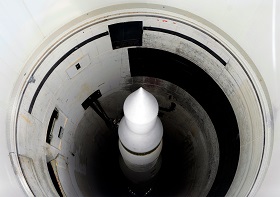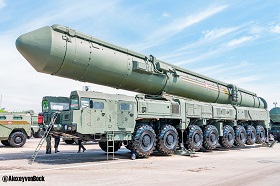Arms Control Is to Be Maintained and Invigorated at All Costs
(votes: 1, rating: 5) |
(1 vote) |
Head of the Center for International Security of IMEMO, RAS Full Member, RIAC member
The past year has brought many new reasons to reflect on the prospects for arms control and strategic stability. A year earlier, the RIAC website published an interview with Aleksey Arbatov, Head of the Center for International Security at the Primakov National Research Institute of World Economy and International Relations (IMEMO), Full Member of the Russian Academy of Sciences and Member of the RIAC. During a conversation on the sidelines of the 13th meeting of the Supervisory Board of the International Luxembourg Forum on Preventing Nuclear Catastrophe, Aleksey Arbatov answered questions from RIAC Expert Ilya Kramnik about the prospects for maintaining the New START Treaty and other developments in the field of nuclear non-proliferation. One of the critical reasons for having this conversation again is the need to consider the principle, recent political development—the results of the U.S. election.
The interview's key topic is what Joe Biden’s presidency means for Russia–U.S. relations and what factors may hinder a compromise in the nuclear sphere?
The past year has brought many new reasons to reflect on the prospects for arms control and strategic stability. A year earlier, the RIAC website published an interview with Aleksey Arbatov, Head of the Center for International Security at the Primakov National Research Institute of World Economy and International Relations (IMEMO), Full Member of the Russian Academy of Sciences and Member of the RIAC. During a conversation on the sidelines of the 13th meeting of the Supervisory Board of the International Luxembourg Forum on Preventing Nuclear Catastrophe, Aleksey Arbatov answered questions from RIAC Expert Ilya Kramnik about the prospects for maintaining the New START Treaty and other developments in the field of nuclear non-proliferation. One of the critical reasons for having this conversation again is the need to consider the principle, recent political development—the results of the U.S. election.
The interview's key topic is what Joe Biden’s presidency means for Russia–U.S. relations and what factors may hinder a compromise in the nuclear sphere?
Mr. Arbatov, a year ago, we talked about the possibility of extending the New START Treaty and that the United States might withdraw from it. Now, with Biden’s victory, what can be said about the prospects for this document?

Talks on a Future START Should Have Been Launched Yesterday
The Treaty will most likely be extended, as promised by Biden during his election campaign. There are several details to be clarified, such as which systems from the Russian side should count towards the ceilings. Russia is known to have agreed that its newest system, the Avangard boost-glide delivery vehicle, should count, as well as the new heavy intercontinental ballistic missile, RS-28 Sarmat, which is to enter service in the near future. No controversy is expected over this. A problem might arise with the Kh-47M2 Kinzhal system. This is an air-launched ballistic missile with a range of 1,500 km. Currently installed on the MiG-31 fighter, it can also be carried by Tu-22M3 medium bombers. Those were a subject of discussion back in the 1970s. The Soviet Union agreed not to equip these aircraft with a refuelling system. That is, not to give them a strategic range, and they were not included in the counting rules under the SALT II agreement signed in 1979.
Now, according to some data, they may get an in-air refuelling system, thereby gaining a much longer range. And they are if equipped with Kinzhal missiles, so this forty-year-old topic, seemingly long forgotten, might return to the agenda. This might delay the extension of the New START.
If we assume that, for some reason, we will not have time to renew the current agreement, will this mean a collapse of the control system as a whole? Or is there sufficient ground for further negotiations and the advance of non-contractual initiatives to temporarily preserve the ceilings and limitations set by the Treaty (for the period of negotiations)?
Most likely, there will be no overall collapse. After all, Biden, unlike Trump, is sincerely committed to arms control. But difficulties will arise, including those of a legal nature, and will have to be addressed. There have already been moments in history when one agreement was terminating while no other was yet entering into force. This happened in the first half of the 1980s, even though the context was different, but it was also the case with the current New START Treaty. START I expired a few months before the new agreement was signed. But no one panicked, as intensive negotiations were underway, and it was clear that a new agreement would be reached soon. With the New START now, of course, the situation is somewhat different. If it is allowed to expire and is not extended, while negotiations on a new treaty have not yet begun, there is a long road ahead. Of course, the situation is more alarming, although the issue of extension can all be resolved both politically and legally, given the parties' goodwill.
For example, they could issue a joint declaration that they would not violate the New START Treaty and preserve its verification regime until its extension. After all, there is no provision in the Treaty requiring that it may only be renewed exactly the moment it expires. This follows from the legal logic, but, ultimately, there is nothing to prevent the parties from adopting such a declaration and extending the Treaty after some delay.
Let’s move on to the possible parameters of a new arms reduction treaty that is not even on the table yet. Last time, you mentioned that the number of factors influencing strategic stability had increased, despite no talks having been held for a long time, and these factors will have to be considered. Which of them must be taken into account now, and which can wait for later stages of the process?
“Take into account” is a very fuzzy term. Policy takes everything into account. Various capabilities of the nine countries that possess nuclear weapons are most likely always taken into account in one way or another. Speaking of expanding the negotiation process, of some third countries being included in the new agreement, this is, of course, a completely different matter. I do not see the possibility of new states joining in the near future. The problem here is that Trump explicitly demanded that China participate in any future treaty. In response, Russia recalled Britain and France, saying that, in this case, they should also negotiate and sign. After that, we parted and without any further progress.
The Democratic Administration led by Biden takes a more flexible and, so far, a less clear position on this issue. They say that, of course, China should be considered, but this does not necessarily apply to any fixed future with regards to strategic weapons. They apparently intend to start negotiating with China on ground-based medium-range missiles. All of this is still unofficial, and people close to the new Administration are now actively discussing these issues and expressing their opinions in various media. Depending on the position taken by the Biden Administration on this issue, negotiations on strategic arms will either begin and continue, or immediately come to a standstill, because Russia will immediately raise the issue of Britain and France. But how can they be included if each of them now has three strategic missile submarines and a fourth one usually in overhaul? No formula has yet been developed for such case. When the first agreement, SALT I, was being negotiated the Soviet side said, "These are American allies, they just must be included under the common ceilings all together, as well as the U.S. forward-based tactical nuclear forces ." Then the agreement would not have been between the USSR and the United States but between the USSR and NATO. For their part, NATO allies would have included Soviet medium range and tactical nuclear weapons. Neither the Americans, or the two other NATO countries or the U.S.S.R could agree on that. Today's situation is very different, but we might again run into a deadlock with France and Britain, as well as with China.

The World after START
If the Americans confine themselves to the question of medium-range missiles, then it is their business with the Chinese. What we need to do regarding such missiles is promote the moratorium that Putin recently proposed: missiles that were banned under the denounced 1987 INF Treaty should not be deployed in the European part of Russia and in the rest of Europe. For verification Putin suggested introducing on-site inspections. This, of course, is very different from the INF Treaty. Nonetheless, it is a basis for an agreement. As for the Asian dimension, the Americans are free to negotiate with the Chinese on their own, and we will see whether we need to deploy something in Asia. Unfortunately, such complex negotiations—in this format and with this number of participants—require that at least two drivers, the leading powers, have some understanding to move in one direction towards an agreement, and not blast full steam ahead towards each other. No such coordination has been reached yet.
The second problem we face is that political relations between Russia and the United States will promptly enter a strained phase. We will begin our relationship with the new Administration (in contrast to the previous one) from a tense and very unfriendly starting point. During the election campaign, Biden said many bad things about Putin and the Putin’s policies. We, for our part, still [as of the evening of December 13] had not congratulated him on his victory. Even though Trump himself has already agreed that he has lost, and China and almost the whole world have already congratulated Biden, we still have not. This, of course, is not because we are waiting for some kind of formal date—this is a matter of politics, not American constitutional procedure. We are thus making it clear to Biden that we are not happy to see him and that we would, of course, have preferred Trump to win. All this creates an unfriendly backdrop for our future relations.
Many significant problems are likely to arise that did not occur with Trump. Human rights, Ukraine and Georgia, Navalny, and so on. All these will occupy a more prominent place. Trump did not care about these things at all. On the other hand he did not do anything good in the area of disarmament, but destroyed everything he could and did nothing positive in other areas of relations with Russia either. Under Trump, we had almost no points of friction, so there were no conflicts, while rhetorically the presidents exchanged pleasantries. We hope that negotiations will resume under Biden, but many other points we disagree on will also arise. It will be difficult to combine progress in the arms control negotiations with aggravation in other political and ideological domains. During the Soviet period, it was sometimes possible to separate these two domains. That is why we could sign several serious disarmament agreements back in those times. What awaits us in the future is not yet clear.
I agree, but I would also like to dwell on some technical problems. When the next START is negotiated, will questions about counting non-nuclear strategic weapons, possibly about missile defence systems, orbital-based systems, have to be raised? Might any of this be on the table?
Everything could be on the table—we have not yet published our position. The relevant agencies are probably urgently preparing their positions for when negotiations begin. This is something we do not know. Looking over sundry statements, remarks and reservations, however, we can draw some conclusions about the main point of contention. That is, if we forget the issue of the format—whether two, three or five countries will participate—which, as we have already discussed, is a dead-end path. We need to conduct bilateral negotiations and deal with the other parties later. After all, the asymmetry of nuclear forces is enormous. Just Russia and the United States still hold 93 per cent of the world’s nuclear arsenals.
As for technical issues, Russia will likely raise the question about non-nuclear strategic offensive systems, as it has been under discussion for a long time. It has not been mentioned in recent months, though. Russia itself has invested heavily in such systems, both sea and air-based, and, as always happens in such cases, the topic is fading a little. I think, however, that it must be discussed. Among the new factors undermining strategic stability, the development of high-precision non-nuclear long-range systems (both air- and sea-based, and then possibly air-based ballistic missiles and non-ballistic hypersonic systems) is, of course, of the greatest concern for strategic stability. The reason is that some important elements of strategic nuclear forces and their command-control systems become vulnerable to non-nuclear strikes, which was not the case before. I believe this must be taken into consideration while negotiating on a new treaty. The United States will, of course, vehemently object, that much is already clear. Instead they will insist on deep cuts in nuclear weapons, including sub-strategic ones. We, for our part, will apparently insist on a reduction that will not be too large in comparison with the ceilings currently in place—700/800 for deployed and non-deployed launchers, 1550 for warheads —but with expanded coverage to include non-nuclear strategic systems. I think our position would be more appropriate in this case and we should stick to it.

Is Non-Nuclear Deterrence Possible?
Another stumbling block is our most advanced systems. That is, the Poseidon underwater intercontinental automatic vehicles and the Burevestnik land-based intercontinental cruise missile equipped with a nuclear engine. The Americans will demand that these capabilities be prohibited. I do not know what our position on this matter will be. Most likely, we will link this with some kind of restrictions of anti-missile defence systems. And the logic here will be that even though these newest capabilities might currently be redundant for overcoming the American missile defence system, as it is not that effective, but in 10–15 years— who knows? Therefore, we may expect that some kind of limitations providing for transparency and predictability of missile defence programmes on both sides will return to the negotiating agenda. Perhaps we will condition it on certain limitations regarding these newest offensive systems we have developed. As for boost-glide hypersonic weapons, we have already agreed to include them. I don’t see any major problems here. If they are installed on intercontinental ballistic booster, they will be automatically included in any subsequent treaty, just as they will be counted if the New START is extended.
Another huge problem, and the most difficult one, is of non-strategic nuclear systems. Trump already raised this question, proposing some odd schemes for “freezing” them, and the Democrats are likely to raise this topic as well. And here we should expect huge contradictions.
Talking about non-strategic nuclear systems, they are also related to the denounced INF Treaty. Does it make sense (and is it even possible) to restore the INF Treaty as a separate agreement? Or would it be more appropriate to include these systems in the general context of START and discuss tactical weapons of other classes separately?
I do not think it will be possible to include them in the general context of strategic offensive arms. There are strategic systems, and there are medium-range ones and the most we can count on soon, as I said, is a moratorium in Europe with on-site inspections. It will be more difficult for the Democratic Administration to reject this offer the same way that Trump walked away without looking. As for the Asia-Pacific region, it is a matter for U.S.–China negotiations. If they find a way to agree on medium-range missiles, good for them! Moreover, one should take care not to put too many eggs in one basket when conducting strategic negotiations. It will already be heavy, so the bottom will definitely fall out if we try to cover everything. However, their insistence on limiting non-strategic nuclear systems might lead the negotiations to a dead end since bringing up short-range land- sea- and air-based tactical systems with a range of up to 500 km would mean opening Pandora ’s Box.
These systems are qualitatively different from strategic ones. Their nuclear charges are not deployed on delivery vehicles in peacetime. They are in depots at armed forces’ bases, in centralized storage facilities and at manufacturing plans. Almost all of their delivery systems are dual-use and we will not be able to limit them as strategic weapons – by launchers, missiles and airplanes. The ceilings would have to be many thousands of units, which is completely meaningless. Consider all the non-strategic weapons of the navies, the weapons of the ground forces and tactical aviation. This is simply unrealistic. Therefore, it is nuclear warheads we will have to talk about. However, we have no experience in this yet; such negotiations have never been held. There were unilateral parallel initiatives to reduce tactical nuclear weapons, which were adopted first by the USSR and the United States, and then by Russia and the United States in the 1990s, but this was not a treaty. These were unilateral measures, a gesture of goodwill. To have any success in this at the negotiating table, we would need to resolve a huge set of problems. I see no prospects for an agreement any time soon and no reason why we should burden the next START Treaty.
I will say just one thing—if you control the weapons inside the storages, then the inspectors should go in there and do the counting. How do you sort and count first-line reserve warheads, partially dismantled warheads and explosive devices that are in line for dismantling and disposal? There are many thousands of them.
Limitation and verification of non-strategic nuclear weapons implies control over the manufacturing plants and associated storages, large centralized storages, and depots at military bases, some of which contain a mix of strategic and tactical nuclear warheads and gravity bombs. By the way, each such plant and centralized nuclear weapons storage facility in our country is located in a closed administrative territorial entity (ZATO)—a closed city surrounded by several security perimeters. This means that the U.S. inspectors would have to permanently live there. There should be build new houses with American conveniences for that purpose, because I do not think they would agree to live in ours. Just as one house was built in Votkinsk, to control the ban on production of medium-range missiles under the INF Treaty, here many more would have to be built. The inspectors would have to be accompanied everywhere while moving around the ZATO, to prevent them contacting working personnel. How many inspectors and accompanying FSB officers would have to work there constantly in order to ensure everything is monitored, but the technical secrets of nuclear weapons are not compromised.
Another scheme that the Trump Administration proposed is also unrealistic. They suggested that we control that the number of nuclear weapons leaving the production plant does not exceed the number that comes to the plant for reprocessing and manufacturing new ones. Allegedly, this would ensure that the total arsenal of nuclear warheads does not grow. However, what if highly enriched uranium or plutonium pits are taken in containers out of dismantled munitions for long-term storage. Should foreign inspectors escort them all the way along the route to make sure they are not delivered as new weapons to military bases or centralized storages escort them? Would you also want to control the huge storages of disposed nuclear materials so that they are not retrieved to produce new warheads? Are the nuclear research and development laboratories to be controlled as well so that they do not manufacture nuclear explosive devices? In fact, this idea implies placing under strict control the whole nuclear industries of the two states.
The scheme is not just artificial, but also unnecessary because neither the Americans nor we are increasing the total number of our nuclear warheads. On the contrary, the total is shrinking. This means that no ceilings will resolve the main problem. It may sound like a nice idea to the common people, but, in practice, it is senseless and infeasible. There are other problems associated with tactical nuclear munitions, but they may be addressed by very different measures.
If it were up to me, I would tell the Americans that, in principle, this issue is not a sacred cow. It can be discussed, but in due time. Let’s first deal with the leftovers of strategic weapons. Why don’t we count, for instance, nuclear air-launched cruise missiles? Under the New START we count each heavy bomber as one delivery vehicle and one warhead while, in fact, it can carry 6 - 20 such missiles. I would also raise the issue of gravity nuclear bombs, which have never been counted under START. Why such an indulgence? If all nuclear warheads are of such concern, let’s begin by counting and controlling these bombs and cruise missiles in depots at air-bases under the overall START warheads ceilings. Furthermore, if we plan to go into centralized storages let us start with counting several thousand strategic warheads, cruise missiles and gravity bombs relocated there from strategic land- and sea-based missiles and heavy bombers to make sure they are not returned to deployed delivery means. Incidentally, in this way we might acquire some experience of controlling non-deployed nuclear warheads and bombs. I would like to see how the Americans react to that.
But with free-fall bombs, are we returning to the question of their placement in Europe?
Yes, some of the bombs are the same there, but they are assigned to tactical aviation. Counting and capping warheads separately from deliver vehicles is an incredibly difficult puzzle. Given a favourable course of events, we will someday get to them, but first let us finish with limiting nuclear weapons at least on heavy bombers. Although B61 bombs used for tactical strike aircraft and for heavy bombers are the same, in the case of heavy bombers, there is every reason to count these bombs under START ceilings according to the actual loading of the aircraft equipped for delivering them—just as we count the warheads of ballistic missiles.
To what extent does the change in the U.S. Administration affect (reduce or, on the contrary, increase?) concerns about the fate of other treaties, including the Comprehensive Nuclear-Test-Ban Treaty (CTBT) and Treaty on the Non-Proliferation of Nuclear Weapons (NPT)? Can we say there is a real threat that the “new nuclear club” might expand further?
There is definitely a threat. Unlike the Cold War, not everything can be controlled by two superpowers. Moreover, they did not control everything even then. It is a myth that the United States and the Soviet Union divided the field between themselves and kept everyone else on a short leash. This was far from the case. It is clear that the new Administration will show much more interest and vigour in strengthening the non-proliferation regime. Again, Trump was indifferent to everything related to nuclear disarmament. However, for the Democrats and Biden personally, it is essential. Finding a way to get back into the Iranian nuclear programme agreement and bringing Iran back into that deal would already be a very important step towards preserving this most important fundamental treaty on nuclear arms control.
That is, the fate of the NPT depends on whether the Americans can get back into the Iranian deal?
Yes, because now even some Democrats are beginning to say that it is impossible to return to the deal in that form, that you cannot enter “the same river twice”, that some additional agreement must be reached. For example, agreements on missile tests, which had been addressed by many UN Security Council resolutions, demanding that Iran stop testing ballistic and other long-range missiles. In addition, they will again demand that Iran wind down its nuclear programme, which it has begun gradually to roll out, violating the limits and bans that were set in the deal. It isn't easy to do something like this automatically. Iran has also accumulated a significant amount of materials, which were severely limited by the deal. Iran began building new nuclear facilities buried in mountain tunnels. We will not only have to sign a memorandum of understanding, we will also have to hold new talks. The new Administration is committed to this. Moreover, the new Administration will surely not indulge in irresponsible and reckless speculation about the resumption of nuclear tests. The Democrats will pursue a more sensible, restrained and constructive line.
Yet not everything depends on the United States. It also depends on what course Russia chooses, whether it will be able to separate from arms control the existing contradictions on international and domestic politics, and even economic and personal sanctions,. We can quarrel with the Americans on various issues as much and as long as we like, but on one important condition. That is - as long as we are alive. We will stay alive if we avoid nuclear war. Until now, this has been possible largely due to the progress of arms control – an indispensable pillar of strategic stability, which is the main guarantee of nuclear war prevention. Hence, arms control is to be preserved and invigorated at all costs.
Interviewed by Ilya Kramnik, RIAC expert, military analyst.
(votes: 1, rating: 5) |
(1 vote) |
A radical reduction in strategic weapons is already impossible without imposing any restrictions on China
Expert Opinions on Russia’s Basic Nuclear Deterrence PrinciplesJune 2020 will go down in the history of Russia’s approaches to nuclear deterrence and nuclear weapons in general
Is Non-Nuclear Deterrence Possible?If hundreds or even thousands of missiles are not enough to force a third-world country to surrender, then how many are needed to deliver unacceptable damage to a major military power?
The World after STARTWe are witnessing the dawn of a new era in our nuclear world






